国际贸易实务双语教程(第4版)Chapter2
国际贸易实务(双语版)教案(2024)

34
2024/1/29
预防措施
加强商品检验、完善合同条款、提高风险防 范意识等
28
不可抗力因素处理
2024/1/29
不可抗力定义
01
自然灾害、战争、政府行为等无法预见、无法避免且无法克服
的客观情况
处理原则
02
及时通知、减轻损失、协商解决、寻求法律援助等
案例分析
03
不同国家或地区对不可抗力的法律规定和判例解析
规定货款的支付方式、支付时间、使用的货币等。
2024/1/29
15
合同条款解析
保险条款
规定由谁负责办理保险、保险金额、保险险别等 。
检验条款
规定商品的检验机构、检验时间、检验方法等。
索赔条款
规定索赔期限、索赔依据、索赔方式等。
2024/1/29
16
合同条款解析
不可抗力条款
规定不可抗力的范围、法律后果等。
根据交易的具体情况选择合适的结算方式,以降低收汇风 险。例如,对于初次交易或信誉不佳的客户,可以选择信 用证等较为安全的结算方式。
及时催收货款
在交易过程中密切关注买方的付款情况,一旦发现买方拖 欠货款或存在其他违约行为,应立即采取相应措施进行催 收或寻求法律救济。
25
06 进出口商品检验 与索赔
2024/1/29
2024/1/29
主要国际贸易惯例介绍
包括《国际贸易术语解释通则》、《跟单信用证统一惯例》、《托收统一规则》等,分 别针对不同环节和要素制定了相应的规则和惯例。
10
03 国际贸易合同磋 商与签订
2024/1/29
11
合同磋商流程
2024/1/29
询盘
国际贸易理论与实务英文版第四版Ch2Classicaltradetheory
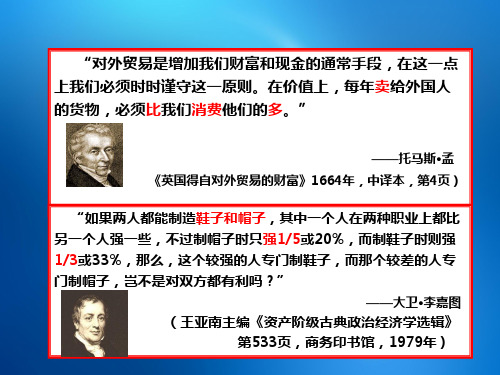
1. Assumptions of the theory of absolute advantage
(1) 2 countries, 2 products. 1 factor of production; (2) Fixed endowment of resources and technology level; (3) Factors of production mobile within a country, immobile
1W: 1.1C ?
(2) In terms of more goods obtained
Portugal Britain
After division of labor
Wine
Cloth
(8+9 ) / 8 = 2.125
(10+ 12) / 10 = 2.2
Portugal Britain
After trading at 1W:1C
10 hrs.
1W : 6/5C
Which country has an absolute advantage in what good(s)?
Portugal: Both.
Which country has a comparative Portugal:Wine.
advantage in what good?
2. Challenge to Mercantilism
(1) Productive capacity
nation's wealth
国际贸易单证实务(第4版)

推荐
本书作者具有多年国际贸易领域的从业经验和教学经验,针对该课程教学的特点,书中收录了大量贸易实际 操作中的单证样本,打造了这本理论与实务并重的教材。
作者简介
吴国新,男,1969年11月生,博士,上海对外经贸大学教授,硕士生导师。浙江省诸暨市人民政府纺织服装 产业专家咨询委员会委员。曾任上海对外贸易学院MBA教育中心执行主任,上海应用技术学院经济与管理学院副 院长等职。主持和承担国家自然科学基金项目、教育部人文社会科学研究项目、上海市哲学社会科学规划项目、 上海市科学技术委员会科研项目、上海高校优秀青年教师后备人选支助项目等10多项科研项目。在等国内外重要 学术期刊上发表30多篇学术论文,其中,1篇被SSCI检索,1篇被EI检索,1篇被人大复印资料全文转载,2篇被 ISTP检索收录。主编《2010上海技术管理研讨会论文集》。2004年12月,被评为上海市优秀青年教师后备人选, 2008年12月,获“上海市优秀青年教师”荣誉称号。
目录
第一章国际贸易单证的基本要求、流程和发展趋势 第一节国际贸易单证的基本要求和业务流程 第二节国际贸易单证的发展趋势 练习题 第二章交易磋商和合同的签订 第一节交易磋商的一般程序 第二节报价和成交核算 第三节书面合同的签订 练习题 第三章国际贸易结算方式 第一节汇付和托收
谢谢观看
国际ቤተ መጻሕፍቲ ባይዱ易单证实务(第4版)
2017年清华大学出版社出版的图书
01 内容简介
03 作者简介
目录
02 推荐 04 目录
《国际贸易单证实务(第4版)》是2017年9月1日清华大学出版社出版的图书,作者是吴国新、李元旭、何 一红。
内容简介
本书突出“应用型”,注重实际操作能力的培养。全书共十三章,按照作者多年从事教学与研究所形成的较 为独特的体系进行安排,内容主要包括国际贸易单证的基本要求、流程和发展趋势,交易磋商和合同的签订,国 际贸易结算方式,信用证在国际贸易结算中的运用,汇票,发票,运输单据,保险单据,原产地证书,检验检疫 单证,进出口货物报关单,进出口许可证及其他单据。
国际贸易实务(英文版)(第四版)(PPT)ppt
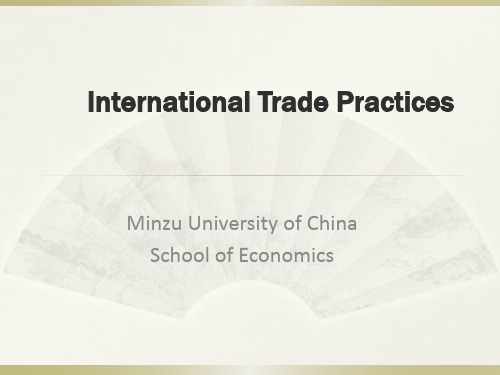
Why trade with other nations?
Advantages
International trade leads to more efficient and increased world production, thus allowing countries (and individuals) to consume a larger and more diverse bundle of goods.
Balance of Payments The balance of payment = the difference between money coming into a country and money going out of the country + money flows coming into or leaving a country from other factors. favorable balance of payments VS unfavorable balance of payments
A nation possessing limited natural resources is able to produce and consume more than it otherwise could.
the establishment of international trade expands the number of potential markets in which a country can sell its goods.
Because the balance of payments is one reflection of a nation's financial stability in the world market, the International Monetary Fund (IMF) uses these accounts to make decisions such as qualifying a country for a loan. The IMF also provides the information to its members so that they can make informed decisions about investments and trade.
《国际贸易实务与操作》Chapter 2

Section 2 Structure and Sequence of Negotiations
The negotiation process can also be summarized as: (1) Inquiry, (2) Offer, (3) Counteroffer, (4) Acceptance. The two sides should make sure to have identical understanding of the terms to which they are agreeing when the bargain is being made.
9
Section 2 Structure and Sequence of Negotiations
2. The Follow Up The stage covers a broad period of bargaining. Each side starts significantly to adjust its demand and attitudes to the observed behavior of the other. It is important to limit the amount of initial concession. The negotiators should know the effect of time limit on negotiations.
16
Section 3 Structure and Contents of Sales Contract
Preamble: title, registered name of the company, address of operation/residence and contact information, date and place for signing of the contract. Body: Name of the Commodity; Quality; Quantity; Unit Price; Packing; Payment; Shipment; Commodity Inspection; Insurance; Industrial Property Right and Patent; Claim and Dispute Settlement; Clause of Force Majeure; Miscellaneous and so on.
国际贸易实务双语教程课后题答案

KeyChapter1I. Answer my questions1. International trade is business whose activities involve the crossing of national borders. It includes not only international trade and foreign manufacturing but also encompasses the growing services industry in areas such as transportation, tourism, banking, advertising, construction, retailing, wholesaling, and mass communications. It includes all business transactions that involve two or more countries. Such business relationship may be private or governmental.2. Sales expansion, resource acquisition and diversification of sales and supplies.3. To gain profit.4. To seej out foreign markets and procurement.5. There are four major forms which are the following:Merchandise exports and Imports, Service Exports and Imports, Investment and Multinational Enterprise.6. It is the account which is a summary statement of the flow of all international economic and financial transactions between one nation (eg.the United States ) and the rest of the world over some period of time, usually one year.7. Merchandise Exporting and Importing.8. Yes. There are great differences between them.1) direct investment takes place when control follows the investment. It usually means high commitment of capital, personnel, and technology abroad. It aims at gaining of foreign resources and foreign markets. Direct investment may often get higher foreign sales than exporting. And sometimes it involves two or more parties.2) While portfolio investments are not under control. And they are used primarilyfor financial purposes. Treasures of companies, for example, routinely more funds from one country to another to get a higher yield on short term investments.9. MNE is the abbreviation of the multinational enterprise. Its synonyms are NNC (the multinational corporation) and TNC (transnational corporation).10. Examples are travel, transport, fee, royalties, dividends and interest.11. The choice of forms is influenced by the objective being pursued and the environments in which the company must operate.12. It is limited by the number of people interested in a firm’s products and services and by customers’ capacity to make purchase.13. This is because at an early stage of international involvement these operations usually take the least commitme nt and least risk of a firm’s resources.14. Royalties means the payment for use of assets from abroad, such as for trademarks patens, copyrights, or other expertise under contract known as licencing agreements.Royalties are also paid franchising.15. It is a way of doing business in which one party (the franchiser) the use of a trademark that is an essential asset for the franchisers’ business.II Match each one on the left with its correct meaning on the right1. J2.A3.E4.B5.C6.D7.I8.G9.F 10.HIII Translate the following terms and phrases into Chinese1 购买力11 经济复苏;恢复2 潜在销售量12 经济衰退3 加价,涨价13 间接投资4 国内市场14 有形货物5 制成品15 有形进出口6 边际利润16 收入及支出;岁入及岁出7 市场占有率17 超额能力8 贸易歧视18 贸易中间人(商);经纪人9 时机选择19 全部包建的工程承包方式10 经销周期20 许可证协定IV Translate the following into English1. Trade is often the ‘engine’ of growt h. However oversimplified this metaphormay be, it does serve to underline the importance of foreign trade in the process of growth. A healthy expansion of exports may not always be sufficient condition for rapid and sustained growth, but a strong positive association between the two is clearly undeniable. Trade expansion contributes to economic growth in many ways. Among them are the benefits of specialization; the favorable effects of international competition on domestic economic efficiency; the increased capacity to pay for the imports required in development and more generally the stimulus to investment.2. International trade is the exchange of goods and services produced in one country for goods and services produced in another country. In addition to visible trade, which involves the import and export of goods and merchandise, there is also invisible trade, which involves the exchange of services between nations. Nations such as Greece and Norway have large maritime fleets and provide transportation service. This is a kind of invisible trade. Invisible trade can be as important to some nations as the export of raw materials or commodities is to others. In both cases, the nations earn the money to buy necessities.3. There exist different ways of conducting international business. Exclusive sale means the seller gives the overseas client the exclusive right of selling a particular product in a designated area within a specified period of time. In this kind of business transaction, the product is bought by the exclusive seller and therefore he should sell the product by himself, assuming sole responsibilities for his profit and loss. Exclusive sale is different from agency where only commission is involved. And difference exists between general contract and exclusive sales because the exclusive seller enjoys exclusive right in a particular area.4. There is no country in the world that can produce all the products it needs.Thus countries join in international division of labor for effective production and reproduction. Sometimes a country can buy goods and services from abroad on a barter basis. Barter means doing business by exchanging goods of one sort for goods of another sort without using money. Barter trade itself is not enough to meat a country’s imp ort needs. But as a form of international trade, it is still attractive in developing countries where foreign exchange is in short supply and inflow of foreign funds is far from sufficient to meet their obligations in external trade.I. Answer the following questions(Omited)II. Filling the blanks with the suitable words in the text:1.meeting/satisfying;2.agent, foreign/overseas;mission;4.own;5.setting;6.patent;7.profits;8.outlets;9.joint, venture; 10.subsidiaryIII.Translate the followings into English1). Economic activity began with the cavemen, who was economicallyself-sufficient. He did his own hunting, found his own shelter, and provided for his own needs. As primitive populations grew and developed, the principle of division of labor evolved. One person was more able to perform some activity than another, and therefore each person concentrated on what he did best. While one hunted, another fished. The hunter then traded his surplus to the fisherman, and each benefited from the variety of diet.In today’s complex economic world, neither individuals nor nations areself-sufficient nations are self-sufficient. Nations have utilized different economic resources; people have developed different skills. This is the foundation of international trade and economic activities.Foreign trade, the exchange of goods between nations, takes place for many reasons. The first, as mentioned above, is that no nation has all of the commodities than it needs. Raw materials are scattered around the world. Large deposits of copper are mined in Peru and Zaire, diamonds are mined in South Africa, and petroleum is recovered in Middle East. Countries that do not have these resources within their own boundaries must buy from countries that export them.Foreign trade also occurs because a country often does not have enough of a particular item to meet its needs. Although the United States is a major producer of sugar, it consumes more than it can produce internally and thus must import sugar. Third, one nation can sell some items at a lower cost than other countries. Japanhas been able to export large quantities of radios and television sets because it can produce them more efficiently than other countries. It is cheaper for the United States to buy these from Japan than to produce them domestically.Finally, foreign trade takes place because of innovation or style. Even though the United States produces more automobiles than any other country, it still imports large quantities of autos from Germany, Japan and Sweden, primarily because there is a market for them in the United States.2). The different kinds of trade nations engaged in are varied and complex, a mixture of visible and invisible trade. Most nations are more dependent on exports than on any other activity. The earnings from exports pay for the imports that they need and want. A nation’s balance of payment is a record of these complex transactions. By reflecting all of these transactions in monetary terms , a nation is able to combine the income it receives, for example, from exports, tourists expenditures, and immigrant remittances. This combined incomes is then spent on such items as manufactured goods from other countries, travel for its citizens to other countries, and the hiring of construction engineers.I. Translate the followings from Chinese into English:1 terms of payment2 written form of contract3 execution of the contract4 sales contract5 purchase confirmation6 terms of transaction7 trading partners 8 the setting up of a contract9 trade agreement 10 consignment contract11 the contract proper 12 extension of the contract13 the contracting parties 14 special clause15 general terms and conditionsII. Answer the following questions in English:1 A contract is an agreement which sets forth bind obligations of the relevant parties. And any part that fails to fulfill his contractual obligations may be sued and forced to make compensation.2 There are two parties of business contract negotiations: oral and written. The former refers to direct discussions abroad; written negotiations often begin with enquiries made by the buyers.3 A written contract is generally prepared and signed as the proof of the agreement and as the basis for its execution. A sales or purchase confirmation is less detailed than a contract, covering only the essential terms of the transaction. It is usually used for smaller deals or between familiar trade partners.4 The setting up of a contract is similar to that of a trade agreement or any othertype of formal agreements. It generally contains: 1) the title. The type of the contract is indicated in the title; 2) the contract proper. It is the main part of a contract; 3) the signature of the contracting parties indicating their status as the seller or the buyer; 4) the stipulations on the back of the contract and are equally binding upon the contracting parties.5 It generally contains the time of shipment, the mode of payment described in addition to an exact description of the goods including the quantity, quality, specifications, packing methods, insurance, commodity inspection, claims, arbitration and force majeure, etc.III. Translate the following into Chinese:合同是在双方达成协议的基础上制定的,而协议又是双方进行商务谈判的结果。
国际贸易理论与实务(英文版)(第四版) Ch.10 GATT and WTO 20151103
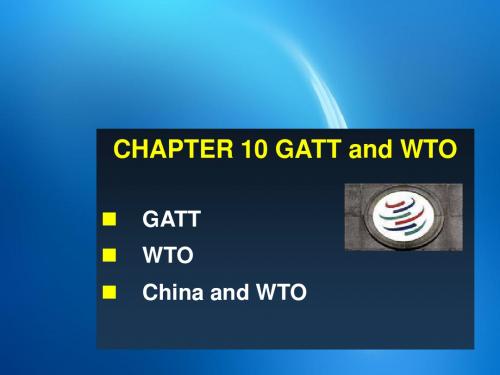
3. The UruБайду номын сангаасuay Round of trade negotiations (1986-94)
Problems 1: GATT’s credibility and effectiveness were undermined: Governments in Western Europe and North America seek bilateral market-sharing arrangements with competitors and embark on a subsidies race to maintain their holds on agricultural trade.
The US led the way into a new round of negotiations from 1964 to 1967. Tariffs on manufactured products were reduced by an average of 35%.
Little progress was achieved in reducing barriers on agricultural products.
(1)
The first five rounds of trade negotiations (1947-1961) Some multilateral tariff reductions were achieved.
Year Place/name Subjects covered Countries
industrial products down to 4.7%.
A series of agreements on non-tariff barriers did emerge from the negotiations, in some cases interpreting existing GATT rules, in others breaking entirely new ground. It failed to come to grip with the fundamental problems affecting farm trade and also stopped short of (不再)providing a modified agreement on “safeguards” (emergency import measures).
国际贸易实务(周瑞琪等)课后答案详解
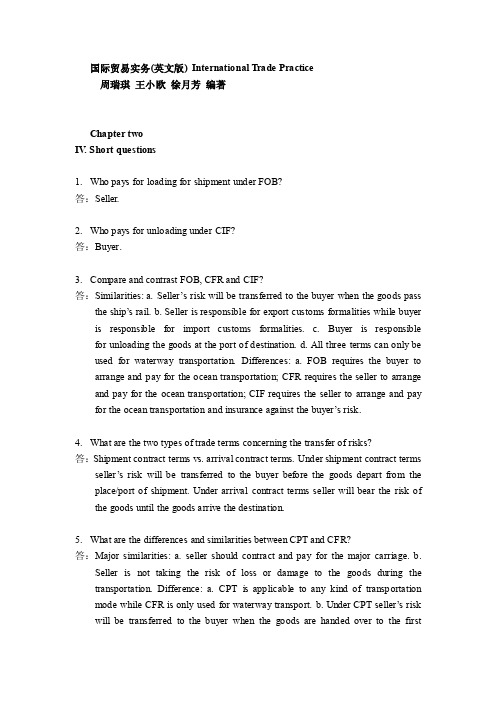
国际贸易实务(英文版) Internationa l Trade Prac tice周瑞琪王小欧徐月芳编著Chapter twoIV. Short q uestions1.Wh o pays for l oading for s hipment unde r FOB?答:Sel ler.2.Who pa ys for unloa ding under C IF?答:Buyer.pare an d contrast F OB, CFR andCIF?答:Simil arities: a.Seller’s ris k will be tr ansferred to the buyer w hen the good s pass the s hip’s rail.b. Seller is responsible for exportcustoms form alities whil e buyer is r esponsible f or import cu stoms formal ities. c. Bu yer is respo nsible for u nloading the goods at th e port of de stination. d. All threeterms can on ly be used f or waterwaytransportati on. Differen ces: a. FOBrequires the buyer to ar range and pa y for the oc ean transpor tation; CFRrequires the seller to a rrange and p ay for the o cean transpo rtation; CIF requires th e seller toarrange andpay for theocean transp ortation and insurance a gainst the b uyer’s risk.4.What are t he two types of trade te rms concerni ng the trans fer of risks?答:Shipment contract te rms vs. arri val contract terms. Unde r shipment c ontract term s seller’s r isk will betransferredto the buyer before thegoods depart from the pl ace/port ofshipment. Un der arrivalcontract ter ms seller wi ll bear therisk of thegoods untilthe goods ar rive the des tination.5.W hat are thedifferencesand similari ties between CPT and CFR?答:Major si milarities:a. seller sh ould contrac t and pay fo r the majorcarriage. b.Seller is n ot taking th e risk of lo ss or damage to the good s during the transportat ion. Differe nce: a. CPTis applicabl e to any kin d of transpo rtation mode while CFR i s only usedfor waterway transport.b. Under CPT seller’s ri sk will be t ransferred t o the buyerwhen the goo ds are hande d over to th e firstcarr ier nominate d by seller. Under CFR s eller’s risk will be tra nsferred whe n the goodspass over th e ship’s rai l.6.What are the differe nces and sim ilarities be tween CIP an d CIF?答:Maj or similarit ies: a. sell er should co ntract and p ay for the m ajor carriag e. b.Seller is not taki ng the riskof loss or d amage to the goods durin g the transp ortation. c. Seller must obtain insu rance agains t buyer’s ri sk. Differen ce: a.CPT i s applicable to any kind of transpor tation modewhile CFR is only used f or waterwaytransport. b. Under CPTseller’s ris k will be tr ansferred to the buyer w hen the good s are handed over to the first carri er nominated by seller.Under CFR se ller’s riskwill be tran sferred when the goods p ass over the ship’s rail.7.If you tr ade with anAmerican, is the sales c ontract subj ect to Incot erms withoutany doubt?What shouldyou do?答:No. The Revise d American F oreign Trade Definitions1941 is sti ll in use, e specially am ong the Nort h American a rea. It hasdifferent in terpretation about sometrade terms.The traders should clar ify the choi ce of rulesbefore any f urther discu ssion.8.What are the mos t commonly u sed trade te rms?答:FOB,CFR & CIF.9.Who is respo nsible for c arrying outcustoms form alities forexports unde r an FOBcon tract?答:Sel ler. Accordi ng to Incote rms 2000, ex cept EXW and DDP these t wo terms, al l the othereleven terms require the seller to h andle the ex port customs formalities, while buye r the import customs for malities.10.I f a Chinesetrader signs a FOB Hambu rg contract, is he expor ting or impo rting? 答:Im porting. FOB should be u sed with a “named port o f s hipment”, if Hamburgis the portof shipment, from the Ch inese trader’s perspecti ve, he is im porting.V.Case Studies1. An FOB contract st ipulated, "T he shipmentwill be effe cted in Marc h 2008. If t hevessel fa ils to arriv e at the por t of shipmen t on time, t he seller ag rees to setaside the go ods for addi tional 27 da ys, and thebuyer will b ear all cost s of delay."it turned o ut that unde r the seller's repeatedrequests, th e vessel nam ed by the bu yer finallyarrived at t he port of s hipment on M ay 1. As a r esult, the s eller refuse d to make th e shipment.(1)Was the sell er entitledto compensat ion for thewarehouse re nt, insuranc e andintere st due to th e delay?(2)Ifthe seller h ad sold thegoods to a t hird party o n April 25,should the b uyerpay for the delay?(3)If the selle r had sold t he goods toa third part y on May 1 w ith a better price,washe entitledto any compe nsation?析:a案例中提到“shipm ent will beeffected inMarch 2008”,这种确定装运时间的方式允许在整个3月份期间的任何时间进行装运。
国际贸易实务双语Chapter 2
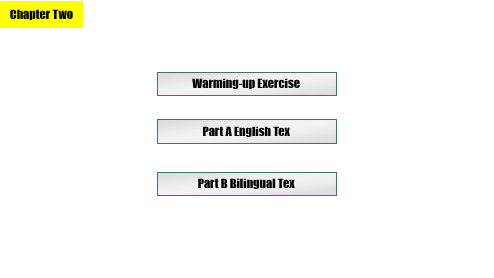
Chapter Two Part A English Tex
Pricing Components of Commoห้องสมุดไป่ตู้ity
Commission Commission is the remuneration paid to the middlemen for their intermediary service for principals. In modern international trade practices, commission takes the form of remuneration which either side of a transaction pays to the middlemen. For example, exporters pay commissions to sales agents or importers pay commissions to purchase agents. Commission is applicable to the contract signed by the exporter/importer and the middlemen. If a percentage as commission rate is specified in the contract, such a commission rate is called defined commission. If there is no such a percentage rate appeared in the contract, we call it an undefined commission. Commission is defined in the following ways: a. Specified with words. Example: USD 150 per M/T CIF San Francisco including 2% commission b. Specified with trade terms. Example: USD 150 per M/T CIFC 2 San Francisco c. Defined by number. Example: Commission: USD25 per Metric Ton
教学课件国际贸易实务双语教程Chapter02InternatioanlTradeTerms

CLASSIFICATIONOF 11 TERMS OF INCOTERMS® 2020
INTEPRETATIONS OF E AND F RULES
• Interpretation of EXW
• On delivery • On import and export clearance • On place of delivery
• Interpபைடு நூலகம்etation of FAS
• On “side of a vessel” • Importance of shipping notice • Different interpretation in Revised American Foreign Trade Definitions 1990
INTERPRETATION OF C RULES
• Interpretation of CPT
• Obligations of the buyer and the seller • To determine the point of delivery and the place of delivery • Unloading costs upon arrival at the place of destination
fulfill the obligation of delivery in the importing country.
INTERPRETATION OF D RULES
帅建林版国际贸易实务课后练习答案(双语)

Chapter 1IYES,Please refer to the 1st paragraph of the text. II流动性过剩自给自足经济资源直接投资国际收支易货交易出口退税倾销出口型经济增长东道国贸易差额贸易顺差/贸易逆差欧盟国际收支顺差/国际收支逆差有形贸易无形贸易货物贸易服务贸易excess liquidityself-sufficienteconomic resourcesdirect investmentbalance of paymentsbarterexport tax rebatedumpingexport-driven economic growthhost countrybalance of tradefavorable/unfavorable balance of trade European Unionfavorable/unfavorable balance of payments visible tradeinvisible tradetrade in goodstrade in servicesIIIThe chart above shows the U.S. imports from China, U.S. exports to China and the trade balance. The U.S. has a negative trade balance with China, and it has been growing. During the period from 1997 to 2003, imports from China have grown 244% while exports to China have grown 221%, indicating that the trade deficit is increasing. There had already been a sizeable trade balance deficit with China in 1996, totaling $ 39.5 billion at the end of the year.IV1. Export goods are tangible goods sent out of countries.2. Trade in services are international earnings other than those derived from the exporting and importing of tangible goods.3. Import goods are tangible goods brought in.4. International trade is all business transactions that involve two or more countries.5. FDI is one that gives the investor a controlling interest in a foreign company.6. Investment is used primarily as financial means for a company to earn more money on its money with relative safety.V1. International trade is the fair and deliberate exchange of goods and/or services across national boundaries. It concerns trade operations of both import and export and includes thepurchase and sale of both visible and invisible goods.2. In today's complex economic world, neither individuals nor nations are self-sufficient. Nations participate in the international trade for many reasons. As to the economic reasons, no nation has all of the economic resources (land, labor and capital) that it needs to develop its economy and culture, and no country enjoys a particular item sufficient enough to meet its needs. As for the preference reasons, international trade takes place because of innovation of style. Besides, every nation can specialize in a certain field and enjoy a comparative advantage in some particular area in terms of trade so that they need to do business with each other to make use of resources more efficiently and effectively.3. In measuring the effectiveness of global trade, nations carefully follow two key indicators, namely, balance of trade and balance of payments.4. FDI, the abbreviation form Foreign Direct Investment, means buying of permanent property and business in foreign nations. It occurs when acquisition of equity interest in a foreign company is trade. The great significance of FDI for China might be that: FDI solve the problem of capital shortage for China so that China may spend the money on importing advanced equipment and technologies for its infrastructure, national supporting industry, key projects, etc.Chapter 2I关税壁垒非关税壁垒从量税配额保护性关税市场失灵幼稚产业许可证制度财政关税政府采购贸易保护主义从价税最低限价本地采购规则增加内需Domestic content Red-tape barriers Export subsidies Binding quota Absolute quotas VERTariff-rate quotas Zero quota "Buy local" rules Tariff barriersnon-tariff barriers specific dutiesquotaprotective tariff market failureinfant industry licensing system Revenue tariff government procurement trade protectionismAd Valorem Duties floor price"buy local" rulesraise domestic demand 国内含量进口环节壁垒出口补贴绑定配额绝对配额自愿出口限制关税配额零配额本地采购原则II1. Protectionism means the deliberate use or encouragement of restrictions on imports to enable relatively inefficient domestic producers to compete successfully with foreign producers.保护主义是指蓄意使用或鼓励进口限制,以此使本国相对效率低的产品能成功地和外国产品竞争。
国际贸易实务双语教程第四版 傅龙海

国际贸易实务双语教程第四版傅龙海1.国际贸易是各国开展经济合作的重要方式。
International trade is an important way for countries to engage in economic cooperation.2.通过国际贸易,各国可以互通有无,实现互利共赢。
Through international trade, countries can exchange resources and achieve mutual benefits.3.国际贸易有助于促进世界经济的繁荣发展。
International trade helps promote the prosperity and development of the world economy.4.了解国际贸易的基本知识对于经济学习者来说非常重要。
Understanding the basics of international trade is crucial for students of economics.5.国际贸易实务涉及到很多复杂的问题和程序。
International trade practice involves many complex issues and procedures.6.进出口业务需要遵守国际贸易法规和惯例。
Import and export business require compliance with international trade regulations and practices.7.知识产权在国际贸易中具有重要的保护作用。
Intellectual property rights play an important protective role in international trade.8.贸易摩擦可能影响国际贸易的正常进行。
Trade frictions may affect the normal conduct of international trade.9.国际贸易需要通过谈判和协商来解决分歧。
国际贸易实务(第四版)案例解析

第一章国际贸易的基本流程和适用的法律【案例讨论】1、2008年12月,中国天津A公司与某国设在中国广州的外商独资企业B 公司在大连签订一份货物买卖合同,合同规定,由B公司向A公司出售一批移动电信设备,总金额为200万美元,交货地点在A公司设在沈阳的仓库。
合同进一步规定,双方当事人如因在合同履行过程中发生争议,可进行友好协商解决;如协商未果,则自愿提交中国国际经济贸易仲裁委员会深圳分会仲裁,其结果为终局性的,对双方均产生约束力,并明确双方所适用的法律为《联合国1980年国际货物销售合同公约》。
试分析,双方当事人对上述合同条款所作出的法律适用方面的选择是否恰当?答案要点:目前,在国际上,与国际贸易关系较为密切的国际贸易条约主要是《联合国国际货物销售合同公约》。
我国是《国际货物销售合同公约》的最早成员国之一,但在1986年核准《公约》时, 对《公约》提出了两项重要的保留:其一是对《公约》适用范围的保留。
《公约》规定,如果合同双方当事人的营业地是处于不同的国家,而且这些国家都是该公约的缔约国,该公约就适用于他们之间订立的货物买卖合同,即该公约适用于营业地处于不同的缔约国的当事人之间订立的买卖合同。
该款中的又规定,只要双方当事人的营业地是处于不同的国家,即使他们的营业地所在国不是公约的缔约国,但如果按照国际私法的规则导致适用某一缔约国的法律,则该公约亦将适用于这些当事人之间订立的国际货物买卖合同。
对此,我国提出了保留,即认为公约的适用范围仅限于营业地分处于不同缔约国的当事人之间所订立的货物买卖合同。
在本案中,中国天津A公司与某国设在中国广州的外商独资企业B公司在大连签订的货物买卖合同不是国际货物买卖合同,因此,双方规定所适用的法律为《联合国1980年国际货物销售合同公约》有不妥之处。
2、某年5月10日,中国华东地区A进出口公司电报通知美国B贸易公司,以CIF价格术语向美方出口成品制衣,总价为100万美元,以不可撤销的信用证支付货款。
国际贸易实务(双语)(2024两篇)

国际贸易实务(双语)(二)国际贸易实务(双语)(二)一、贸易保护主义的影响贸易保护主义是指国家采取措施限制或阻止国际贸易的一种政策。
虽然贸易保护主义经常在一些国家的政策中出现,但它对国际贸易的影响是复杂而多样的。
本文将探讨贸易保护主义对国际贸易的影响,并提出应对策略。
首先,贸易保护主义会限制国际贸易的自由度。
国家采取贸易限制措施,如关税和配额,进口商品将受到限制。
这种限制会导致贸易量的减少,从而降低了国际贸易自由度。
此外,贸易保护主义还可能导致贸易伙伴之间的紧张关系升级,产生贸易战等不良后果。
其次,贸易保护主义会导致国际贸易成本的上升。
贸易保护主义措施,如关税和配额,会增加进口商品的价格。
这将使得进口商品变得更加昂贵,从而增加了国内消费者的负担。
此外,贸易保护主义还可能导致生产成本的上升,因为进口原材料的价格上涨。
另外,贸易保护主义还可能导致资源配置不合理。
贸易保护主义限制了国际贸易,使得国内企业无需面对来自国际竞争对手的竞争压力。
这将导致企业之间的竞争减少,从而削弱了企业提高竞争力和创新能力的动力。
此外,贸易保护主义还可能导致资源向效率低下的产业流动,而不是流向更具竞争力的产业,从而损害了整体经济效益。
然而,在应对贸易保护主义的影响时,国际贸易参与方可以采取一些策略来减轻贸易保护主义带来的负面影响。
首先,加强贸易往来国家间的合作与沟通,通过对话解决贸易争端。
此外,应加大对贸易教育和培训的力度,提高企业和从业人员对国际贸易的理解与应对能力。
此外,国际贸易参与方还应积极争取多边和双边的贸易自由化协定,加强贸易合作,降低贸易壁垒。
另外,国际贸易参与方还可以多元化市场,降低对某一地区或国家的依赖。
总之,贸易保护主义对国际贸易的影响是复杂而多样的。
虽然贸易保护主义可能限制国际贸易的自由度,导致成本上升和资源配置不合理,但采取合适的策略可以减轻其负面影响。
国际贸易参与方应加强合作,加大对贸易教育和培训的力度,争取贸易自由化协定,多元化市场,以应对贸易保护主义的挑战,实现可持续的国际贸易发展。
国际贸易实务chapter 2信用证业务操作

43P PARTIAL SHIPMENT 43P 分批装运
第二讲 信用证业务操作
2.1跟单信用证概述
2.1.1 跟单信用证的含义 信用证是指一项不可撤销的约定,无论其名称
或描述如何,该项约定构成开证行对相符提示 予以承付的确定承诺。 承付指:
a.如果信用证为即期付款信用证,则即期付款。 b.如果信用证为延期付款信用证,则承诺延期付
款并在承诺到期日付款。 c.如果信用证为承兑信用证,则承兑受益人开出
10)指定的有关银行与兑付方式
可得到的
议付
41D AVAILABLE WITH …BY… ADVISING BANK ONLY
BY NEGOTIATION 41D 指定的有关银行…兑付方式… 在中国的任一银行,用议付
2.2.2 SWIFT信用证实例评析
兑付的方式有4种:
BY PAYMENT(即期付款); BY ACCEPTANCE(远期承兑); BY NEGOTIATION(议付); BY DEF PAYMENT(迟期付款)
知的信用证 SWIFT信用证开立及其基本内容
2.2 SWIFT信用证
2.2.2 SWIFT信用证实例评析
1)通讯格式
签发
MT700--------ISSUE OF A DOCUMENTARY CREDIT---
MT700
跟单信用证的开立
2)页次
27 SEQUENCE OF TOTAL
1/1
27 页次
11)汇票付款日期
2.2.2 SWIFT信用证实例评析
42C DRAFTS AT… 30 DAYS AFTER SIGHT 42C 汇票付款期限 见票后30天付款
12)汇票付款人
- 1、下载文档前请自行甄别文档内容的完整性,平台不提供额外的编辑、内容补充、找答案等附加服务。
- 2、"仅部分预览"的文档,不可在线预览部分如存在完整性等问题,可反馈申请退款(可完整预览的文档不适用该条件!)。
- 3、如文档侵犯您的权益,请联系客服反馈,我们会尽快为您处理(人工客服工作时间:9:00-18:30)。
Arrival Declare and Discharge
Discharge
Conclusion
Applying Import License Track Goods
Claims, Adjustment
Market Research
Any exporter who wants to sell his products in a foreign country or countries must first conduct a lot of market research.
Customs and Excise officers may need to examine the goods, check import or export licences and charge duty and /or VAT.
A chamber of Commerce may need to issue a certificate of origin, if this is required by the importer’s country.
Market research is a process of conducting research into a specific market for a particular product.
Parties involved in export and import transaction
2. Offer
(1)The meaning of an offer
• An offer is a proposal made by sellers to buyers in order to enter into a contract.
(2)The basic conditions of an offer I ) The offer shall be made to one or more specific persons The offer shall be the definite representation in which the offeror expresses that he shall conclude transaction on the terms and conditions stipulated therein.
* the exporter’s bank
* the importer’s bank
* the railways (in some cases) in the importer’ country
* the road hauler ( in some case) in the importer’ country
Formality: Inquiry ↓ Offer ↓
Counter-offer ↓
Acceptance ↓
Conclusion of Contract Offer, and acceptance are two indispensable links for reaching an agreement
Business Negotiation
The way of Negotiation: Oral, in Written (letter, fax, email, telex, cable, etc.)
Contents: Main terms: quality, quantity, packing, price, ds: insurance, inspection, arbitration, force majeure
transactions
6 Basic Documents needed in Export and Import Transaction
Please look at the following draft (Export Procedures under CIR on the side of Seller)
1) Making market research
2) Marketing and Promotion
3 What is Importing
4 Parties involved in export and import transaction
5 Specialists involved in export and import
Export Procedures under CIR on the side of Seller
Procedures of Import Transaction
Signing Contract Insurance Settlement
Acceptance
Opening L/C Chartering Space Ship
and concluding a contract.
Section Two Business Negotiation
1. The form of business negotiation Two forms: Oral form and written form
2. Main contents of business negotiation (1)Main terms of trade It includes quality, quantity, packaging, price, delivering and terms of payment, etc. (2)General Terms and Conditions
* the road hauler (in some cases) in the exporter’s country
* the exporters * the port authority
* the importers * the shipping company (for sea freight)
* the exporters
* the importers
* the port authority
* the shipping company (for
sea freight)
* the airline (for air freight) * the insurance company or
brokers
* the railways (in some cases) in the importer’ country * the road hauler ( in some case) in the importer’ country * the road hauler ( in some case) in the importer’ country * the shipping agent at the port or airport of discharge * the shipping agents at the port or airport of loading * the railway (in some cases)in the exporters’ country * the road hauler (in some cases) in the exporter’s country
出
商品规格 发盘流程
口
发
价格
支付工具
盘
包装
所
包
船期
含
的
支付条件
信
息
发盘有效期
支付方式
发盘流程
发盘
NO 送达生效 NO 发盘失效
撤
撤
YES
回
消
YES
发盘无效
1. Inquiry
An enquiry is a request for business information, such as price lists, catalogue, samples, and details about the goods or trade terms.
* the airline (for air freight) * the insurance company or brokers
* the exporter’s bank
* the importer’s bank
Parties Involved in Exp. & Imp. Transaction
Chapter 2 General Procedures of Export and Import Transaction
Section One Procedures of Export and Import Transaction
1 What is Exporting
2 Procedures of Export
* the shipping agent at the port or airport of discharge
* the shipping agents at the port or airport of loading
* the railway (in some cases)in the exporters’ country
Specialists involved in export and import transactions
A shipping agent and /or foreign forwarder (forwarding agent) will take responsibility for the documentation and arrange for the goods to be shipped by air, sea, rail or rail. Theses services may be carried out by the supplier’s own export department, if they have the expertise.
